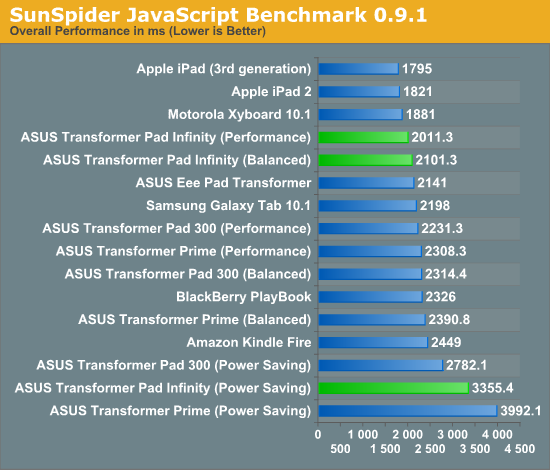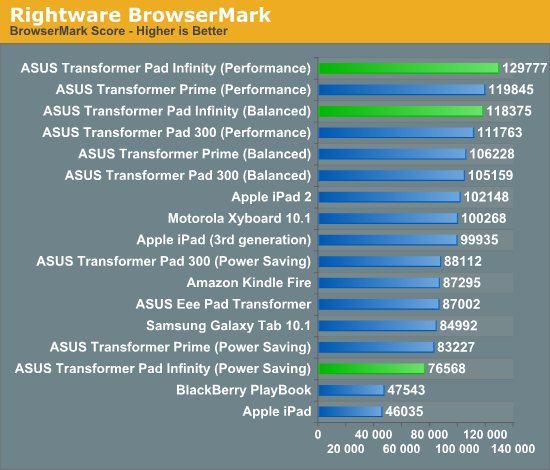ASUS Transformer Pad Infinity (TF700T) Review
by Anand Lal Shimpi on June 25, 2012 3:00 AM ESTA Faster Tegra 3, More Memory Bandwidth
As its new Android tablet flagship, ASUS selected the fastest Tegra 3 SoC NVIDIA is offering today: the T33. Architecturally similar to the rest of the Tegra 3 lineup, the T33 is simply a higher leakage part running at a higher voltage to hit higher clock speeds. Whereas the original T30 used in the Transformer Prime ran at a nominal voltage of 1.15V, the T33 runs at 1.237V. CPU clocks can now reach 1.7GHz with a single core active, or 1.6GHz otherwise.
| NVIDIA Tegra 3 | |||||||
| CPU Cores | Max CPU Clock (1 core active) | Max CPU Clock (multiple cores) | GPU Cores | Max GPU Clock | |||
| NVIDIA Tegra 3 (T33) | 4+1 | 1.7GHz | 1.6GHz | 12 | 520MHz | ||
| NVIDIA Tegra 3 (T30) | 4+1 | 1.4GHz | 1.3GHz | 12 | 520MHz | ||
| NVIDIA Tegra 3 (T30L) | 4+1 | 1.3GHz | 1.2GHz | 12 | 416MHz | ||
ASUS continues to expose control over the CPU governer through its Performance, Balanced and Power Saving modes exposed in ICS. In general, the balanced mode really does deliver nearly max performance (1.5 - 1.6GHz) while power saving significantly clamps CPU clock speeds (1GHz) and is more conservative with ramping up CPU clock to that max. Despite offering support for up to 1.7GHz operation, I typically saw 1.6GHz as a max even in performance mode.


The higher clocked CPU does deliver a tangible performance improvement over the Transformer Prime, and definitely over the original Transformer if you look at the BrowserMark results.
Although GPU clocks remain unchanged, in order to drive the higher resolution panel ASUS outfitted the Infinity with DDR3-1600. If I'm reading the part numbers on the DRAM devices used in previous models it looks like there's a significant increase in memory bandwidth this generation:
| ASUS Transformer Memory Choices | |||||
| TF Prime | TF Pad 300 | TF Pad Infinity | |||
| Memory Capacity | 1GB | 1GB | 1GB | ||
| Memory Type | DDR2-500 | DDR3-667 | DDR3-1600 | ||
| Memory Bandwidth | 2.0GB/s | 2.7GB/s | 6.4GB/s | ||
Remember NVIDIA's Tegra 3 only has a single channel memory interface, so frequency is the only option for increasing memory bandwidth. The increase in bandwidth does make scrolling and most UI interactions fairly smooth, although you will see dropped frames from time to time. I must say I'm fairly impressed by how well ASUS/NVIDIA were able to pull off smoothness without a significant hardware update. It's worth pointing out that the experience is far from perfect though. Even ICS is rough around the edges when it comes to delivering consistent UI performance on a tablet. Google is expected to address this with Jelly Bean but it's something to keep in mind for those buying in the near future. Granted by the time the Infinity is actually available, Jelly Bean may have already launched. As ASUS is widely expected to be a launch partner on Jelly Bean, I wonder if that means TF Pad Infinity owners will get a swift update.










112 Comments
View All Comments
Screammit - Tuesday, June 26, 2012 - link
sadly, "tinkering" for 90% of the public is to change their background picture.Belard - Tuesday, June 26, 2012 - link
" I’m only afraid they will end up being too schizophrenic for that, trying to do it all and ending up doing nothing well enough for people to give a shit."BINGO!
andrewaggb - Monday, June 25, 2012 - link
Personally I haven't been able to use either for work. The TF + dock is almost usable, but it doesn't have enough of the apps I use (I don't want lame substitutes) and ultimately the tf+dock is almost a netbook... so I just use my much more powerful laptop. The ipad is not work worthy. And apple doesn't try to market it that way, so I'm ok with that. I love the ipad for what it is, instant-on, relax on the couch.Surface may be suitable for light work, though I'm not sure how it will work in your lap, so the asus version will probably be better. But I suspect it'll take a good year for the apps to be available for ARM, so at launch I'd be looking at an x86 version... and it doesn't look like AMD or Intel has a tablet winner SOC for the fall. Ivy Bridge will do, but haswell would have been better. And an ultra low voltage trinity maybe?
I'm not certain that when the dust settles I'm going to want to work on a tablet with a keyboard anyways. I like the idea of one less device, but maybe it's a dream. I think phone,tablet,laptop,desktop,xbox/appletv, all play a somewhat different role and I'll probably keep buying all of them.
I like the concept of running windows 8 on everything, but I'm currently mixing android,apple,and lots of microsoft and I'm getting along just fine :-)
kmmatney - Monday, June 25, 2012 - link
" BUT what disadvantages do you get? On Android I have none, except of voiding my warranty."I have my iPad 2 Jailbroken, and there are no disadvantages - at least none that I've ever come across. The advantage is being able to install RetinaPad, iFile, NES emulators with Wiimote support, and a few UI customization apps.
DeciusStrabo - Tuesday, June 26, 2012 - link
My iPad 2 slowed down a lot when I jailbroke it and installed some jailbroken software. It was rather annoying and the reason I went back into Apple's golden cage. No such issue with rooted/custom-ROM Android, where you rather see a stability and speed increase, not a decrease.BabelHuber - Monday, June 25, 2012 - link
I miss tests of actual games on the TF Infinity.The TF Prime is a real joy in this regard. Shadowgun, GTA3, Max Payne, N:OV.A. 3, everything is running smooth like butter, but only at 720p.
How does the TF Infinity play these games? With its 1080p resolution the GPU has much more to do, especially the Pixel Shaders.
So, does the higher-clocked Tegra 3 with its enhanced bandwith compensate for the higher screen resolution?
XZerg - Monday, June 25, 2012 - link
^^ when?bleh0 - Monday, June 25, 2012 - link
I love the form factor of the Transformer series but it needs RT. With Nvidia being the ARM partner for Microsoft at the moment we might see better battery life and performance out of RT then under Android. As always I'll be waiting patiently for the Anandtech review when the device is released.jwcalla - Monday, June 25, 2012 - link
Maybe slapping Ubuntu for Android would help seal the deal on this thing. You get the "hybrid device" feel that Windows is going for, plus you have the Android app ecosystem to work with.Quad-core Cortex A15s will be interesting as you could run two operating systems (like Ubuntu and Android) simultaneously. And Ubuntu is surprisingly mature and smooth on ARM w/ GPU acceleration.
riottime - Monday, June 25, 2012 - link
it's alright tablet but i'll wait for win8 surface. i own ep121 and it's still working great with i5 cpu. i might just upgrade the os on it to win8 when that comes out instead of buying a brand new 'surface' tablet. as for android, my samsung player 4 is sufficient. :)